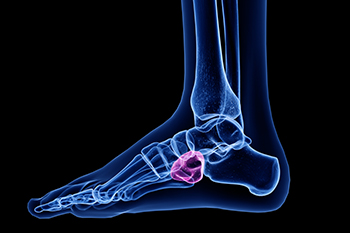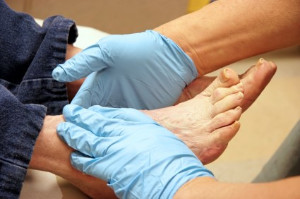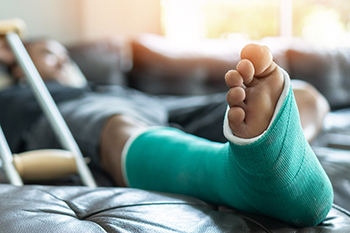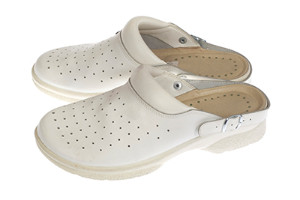Connect With Us
Blog
Items filtered by date: July 2025
Relieving Foot Pain from Cuboid Syndrome

Cuboid syndrome is a condition where the cuboid bone in the foot becomes misaligned, often causing sharp pain along the outer side of the foot. It can result from overuse, ankle sprains, or repetitive stress from activities like running or jumping. Risk factors include wearing improper footwear, flat feet, or uneven gait patterns. Symptoms may include localized pain, weakness, and difficulty bearing weight. The cuboid whip is a manual technique used to realign the bone quickly and effectively, often providing immediate relief. A podiatrist can diagnose cuboid syndrome through a physical examination and provide treatments such as manipulation, orthotics, and rehabilitation. If you are experiencing foot pain, it is suggested that you consult a podiatrist who can provide an accurate diagnosis and treatment.
Cuboid syndrome, also known as cuboid subluxation, occurs when the joints and ligaments near the cuboid bone in the foot become torn. If you have cuboid syndrome, consult with Michele Kraft, DPM from Toes on the Go. Our doctor will assess your condition and provide you with quality foot and ankle treatment.
Cuboid syndrome is a common cause of lateral foot pain, which is pain on the outside of the foot. The condition may happen suddenly due to an ankle sprain, or it may develop slowly overtime from repetitive tension through the bone and surrounding structures.
Causes
The most common causes of cuboid syndrome include:
- Injury – The most common cause of this ailment is an ankle sprain.
- Repetitive Strain – Tension placed through the peroneus longus muscle from repetitive activities such as jumping and running may cause excessive traction on the bone causing it to sublux.
- Altered Foot Biomechanics – Most people suffering from cuboid subluxation have flat feet.
Symptoms
A common symptom of cuboid syndrome is pain along the outside of the foot which can be felt in the ankle and toes. This pain may create walking difficulties and may cause those with the condition to walk with a limp.
Diagnosis
Diagnosis of cuboid syndrome is often difficult, and it is often misdiagnosed. X-rays, MRIs and CT scans often fail to properly show the cuboid subluxation. Although there isn’t a specific test used to diagnose cuboid syndrome, your podiatrist will usually check if pain is felt while pressing firmly on the cuboid bone of your foot.
Treatment
Just as the range of causes varies widely, so do treatments. Some more common treatments are ice therapy, rest, exercise, taping, and orthotics.
If you have any questions, please feel free to contact our office located in Carmel, CA . We offer the newest diagnostic and treatment technologies for all your foot care needs.
Why Diabetes and Foot Problems Often Go Hand in Hand

Diabetes can quietly affect the feet in serious ways. Changes in circulation and nerve function may cause numbness, making it harder to feel blisters, cuts, or pressure points. Without early detection, even small issues can turn into infections or open sores that are slow to heal. Dry skin, foot deformities, and nail problems are also more common with diabetes, increasing the risk of complications. Regular foot checks and wearing protective shoes are important steps in prevention. Staying alert to changes in skin color, temperature, or sensation can help stop problems before they start. Because diabetic foot issues can worsen quickly, proper care is essential. If you have diabetes and notice foot pain, discoloration, or any break in the skin, it is suggested that you promptly see a podiatrist for a full evaluation and a care plan designed to keep your feet healthy.
Diabetic foot care is important in preventing foot ailments such as ulcers. If you are suffering from diabetes or have any other concerns about your feet, contact Michele Kraft, DPM from Toes on the Go. Our doctor can provide the care you need to keep you pain-free and on your feet.
Diabetic Foot Care
Diabetes affects millions of people every year. The condition can damage blood vessels in many parts of the body, especially the feet. Because of this, taking care of your feet is essential if you have diabetes, and having a podiatrist help monitor your foot health is highly recommended.
The Importance of Caring for Your Feet
- Routinely inspect your feet for bruises or sores.
- Wear socks that fit your feet comfortably.
- Wear comfortable shoes that provide adequate support.
Patients with diabetes should have their doctor monitor their blood levels, as blood sugar levels play such a huge role in diabetic care. Monitoring these levels on a regular basis is highly advised.
It is always best to inform your healthcare professional of any concerns you may have regarding your feet, especially for diabetic patients. Early treatment and routine foot examinations are keys to maintaining proper health, especially because severe complications can arise if proper treatment is not applied.
If you have any questions, please feel free to contact our office located in Carmel, CA . We offer the newest diagnostic and treatment technologies for all your foot care needs.
Preventing Workplace Falls and Safety Tips

Preventing workplace falls begins with proper training and awareness. Safe use of ladders includes placing them on stable surfaces and maintaining three points of contact while climbing. Scaffolding must be properly assembled with guardrails and secure platforms. In construction and other high-risk jobs, wearing the correct footwear and keeping walkways clear of debris are essential. Reducing slips and falls involves cleaning spills quickly, using slip-resistant mats, and wearing shoes with good traction. A podiatrist can recommend supportive footwear or orthotics to improve stability and help address foot pain that may affect balance. If you have sustained a foot and ankle injury while working, it is suggested that you visit a podiatrist who can treat various foot conditions, and guide you toward effective fall prevention tips.
Preventing falls among the elderly is very important. If you are older and have fallen or fear that you are prone to falling, consult with Michele Kraft, DPM from Toes on the Go. Our doctor will assess your condition and provide you with quality advice and care.
Every 11 seconds, an elderly American is being treated in an emergency room for a fall related injury. Falls are the leading cause of head and hip injuries for those 65 and older. Due to decreases in strength, balance, senses, and lack of awareness, elderly persons are very susceptible to falling. Thankfully, there are a number of things older persons can do to prevent falls.
How to Prevent Falls
Some effective methods that older persons can do to prevent falls include:
- Enrolling in strength and balance exercise program to increase balance and strength
- Periodically having your sight and hearing checked
- Discuss any medications you have with a doctor to see if it increases the risk of falling
- Clearing the house of falling hazards and installing devices like grab bars and railings
- Utilizing a walker or cane
- Wearing shoes that provide good support and cushioning
- Talking to family members about falling and increasing awareness
Falling can be a traumatic and embarrassing experience for elderly persons; this can make them less willing to leave the house, and less willing to talk to someone about their fears of falling. Doing such things, however, will increase the likelihood of tripping or losing one’s balance. Knowing the causes of falling and how to prevent them is the best way to mitigate the risk of serious injury.
If you have any questions, please feel free to contact our office located in Carmel, CA . We offer the newest diagnostic and treatment technologies for all your foot care needs.
Muscle and Joint Problems in the Foot and Ankle

The feet and ankles are made up of many moving parts that work together to support your body. When muscles, joints, or connective tissues are strained or injured, pain and limited movement often follow. Conditions such as joint wear, strained tendons, or soft tissue injuries can develop from overuse, misalignment, or previous trauma. These problems may cause swelling, stiffness, or difficulty standing and walking comfortably. A complete evaluation, which may include movement testing or imaging, helps identify the exact source of discomfort. Care plans are often tailored and may involve supportive inserts, specific exercises, or bracing. If pain does not improve, further options such as guided injections or surgery may be discussed. Addressing the issue early may help avoid worsening symptoms or additional strain on other areas. If your foot or ankle is causing persistent pain or limiting your activity, it is suggested that you see a podiatrist for a diagnosis and appropriate treatment.
Foot and ankle trauma is common among athletes and the elderly. If you have concerns that you may have experienced trauma to the foot and ankle, consult with Michele Kraft, DPM from Toes on the Go. Our doctor will assess your condition and provide you with quality foot and ankle treatment.
Foot and ankle trauma cover a range of injuries all over the foot; common injuries include:
- Broken bones
- Muscle strains
- Injuries to the tendons and ligaments
- Stress fractures
Symptoms
Symptoms of foot and ankle injuries vary depending on the injury, but more common ones include:
- Bruising
- Inflammation/ Swelling
- Pain
Diagnosis
To properly diagnose the exact type of injury, podiatrists will conduct a number of different tests. Some of these include sensation and visual tests, X-rays, and MRIs. Medical and family histories will also be taken into account.
Treatment
Once the injury has been diagnosed, the podiatrist can than offer the best treatment options for you. In less severe cases, rest and keeping pressure off the foot may be all that’s necessary. Orthotics, such as a specially made shoes, or immobilization devices, like splints or casts, may be deemed necessary. Finally, if the injury is severe enough, surgery may be necessary.
If you have any questions, please feel free to contact our office located in Carmel, CA . We offer the newest diagnostic and treatment technologies for all your foot care needs.
Do You Suffer From Painful Feet?
Why Bargain Shoes May Lead to Bigger Problems

Shoes made with low-quality materials or poor construction may seem appealing due to their price, but they can take a toll on your foot health, over time. Without proper support, cushioning, or fit, these shoes may contribute to fatigue, pain, and misalignment in the feet and legs. Flat soles and flimsy arch support can lead to overuse injuries or worsen existing conditions, such as heel pain or hammertoes. Wearing unsupportive footwear regularly may also affect posture and place added strain on the knees, hips, or lower back. Replacing shoes frequently or seeking treatment for chronic foot issues can become more expensive than investing in proper footwear from the start. If you are experiencing foot discomfort that may be related to your shoes, it is suggested that you consult a podiatrist for expert advice, care, and qualities to look for in good shoes.
Foot Pain
Foot pain can be extremely painful and debilitating. If you have a foot pain, consult with Michele Kraft, DPM from Toes on the Go. Our doctor will assess your condition and provide you with quality foot and ankle treatment.
Causes
Foot pain is a very broad condition that could be caused by one or more ailments. The most common include:
- Bunions
- Hammertoes
- Plantar Fasciitis
- Bone Spurs
- Corns
- Tarsal Tunnel Syndrome
- Ingrown Toenails
- Arthritis (such as Gout, Rheumatoid, and Osteoarthritis)
- Flat Feet
- Injury (from stress fractures, broken toe, foot, ankle, Achilles tendon ruptures, and sprains)
- And more
Diagnosis
To figure out the cause of foot pain, podiatrists utilize several different methods. This can range from simple visual inspections and sensation tests to X-rays and MRI scans. Prior medical history, family medical history, and any recent physical traumatic events will all be taken into consideration for a proper diagnosis.
Treatment
Treatment depends upon the cause of the foot pain. Whether it is resting, staying off the foot, or having surgery; podiatrists have a number of treatment options available for foot pain.
If you have any questions, please feel free to contact our office located in Carmel, CA . We offer the newest diagnostic and treatment technologies for all your foot care needs.

